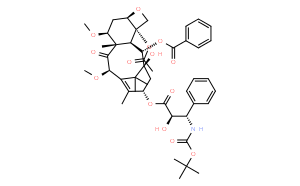
 COA COA |
 MSDS MSDS |
 HPLC HPLC |
 NMR NMR |
| CAS No: | 183133-96-2 |
| Molecular formula(MF) | C45H57NO14 |
| Molecular Weight(MW): | 835.93 |
| Alias |
| In vitro | DMSO | 100 mg/mL (119.62 mM) |
|---|---|---|
| Water | <1 mg/mL | |
| Ethanol | <1 mg/mL | |
| In vivo |
| Description | Cabazitaxel is a semi-synthetic derivative of a natural taxoid that kills cancer cells by inhibiting cell division and growth. Cabazitaxel exerts its effects by inhibiting microtubule growth and assembly, processes that are essential for cells to divide. | ||||||||||||||||||||||||||||||||||||||||||||||||||||||||||
|---|---|---|---|---|---|---|---|---|---|---|---|---|---|---|---|---|---|---|---|---|---|---|---|---|---|---|---|---|---|---|---|---|---|---|---|---|---|---|---|---|---|---|---|---|---|---|---|---|---|---|---|---|---|---|---|---|---|---|---|
| Features | A semi-synthetic derivative of a natural taxoid. | ||||||||||||||||||||||||||||||||||||||||||||||||||||||||||
| Targets |
|
||||||||||||||||||||||||||||||||||||||||||||||||||||||||||
| In vitro |
Cabazitaxel increases CYP3A enzyme activities in rat hepatocytes. The mean ex-vivo human plasma protein binding of Cabazitaxel is 91.6%. Cabazitaxel is rapidly and extensively metabolised in numerous metabolites. Cabazitaxel demonstrates activity in several murine and human resistant cell lines. [1] With a 4-day exposure to cabazitaxel, cytotoxicity is noted with relatively low cabazitaxel concentrations. Cabazitaxel shows high antitumor activity in 3 human colorectal cell lines (HCT-116, HCT-8, and HT-29). [2] |
||||||||||||||||||||||||||||||||||||||||||||||||||||||||||
| Cell Data |
|
||||||||||||||||||||||||||||||||||||||||||||||||||||||||||
| In vivo | In accompanying models, Cabazitaxel is noted to have significant antitumor activity. In murine tumor xenografts (colon C38 and pancreas P03), Cabazitaxel elicites complete tumor regressions. Using SF-295 and U251 human glioblastoma cell lines, both orthotopic and subcutaneous murine xenografts are generated. Cabazitaxel treatment leads to complete regression in the majority of subcutaneously implanted tumors. Furthermore, in orthotopic models, Cabazitaxel leads to complete tumor regression in 4 out of 10 U251 tumors. [2] |